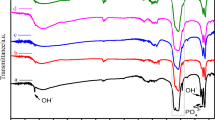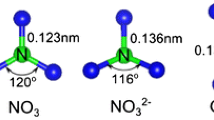Abstract
Ab initio density functional plane-wave calculations are performed on silicon-substituted hydroxyapatite (SiHA). Formation energies are obtained for the substitution of a phosphorus atom by a silicon atom in each of the six phosphate groups of the unit cell in turn. It is found that the co-removal of a hydroxyl group to maintain charge neutrality is energetically favourable and the calculated unit cell volumes for the single silicon substitutions agree extremely well with experimental observation. The substitution of a second silicon atom in the unit cell is found to be almost as energetically favourable as the first (and on one site more favourable) and there can be an attractive interaction between the two Si substituents when they are closely separated. However, experimental observation suggests that for this concentration of silicon a phase transformation to a different structure occurs which, because of the imposed boundary conditions, could not be accessed in the calculations. The density of states of the SiHA indicates that new states are introduced deep into the valence band and the band gap decreases by 1.6 eV compared to phase-pure HA. No new states are introduced into the band gap indicating that the Si incorporation does not make the material inherently electrically active. Furthermore a population analysis shows that the Si impurity has only a small effect on the neighbouring ionic charge.




Similar content being viewed by others
References
N. H. DE LEEUW, Chem. Commun. 17 (2001) 1646
S. M. REA, S. M. BEST and W. BONFIELD, J. Mater. Sci. Mater. Med. 15(9) (2004) 997
A. PEETERS, E. A. P. DE MAEYER, C. VAN ALSENOY and R. M. H. VERBEECK, Phys. Chem. B 101 (1997) 3995
T. KOBAYASHI, S. NAKAMURA and K. YAMASHITA, J. Biomed. Mater. Res. 57 (2001) 477
N. H. DE LEEUW, Phys. Chem. Chem. Phys. 4 (2002) 3865
N. H. DE LEEUW, J. Phys. Chem. B 108(6) (2004) 1809
I. R. GIBSON, S. M. BEST and W. BONFIELD, J. Biomed. Mater. Res. 44 (1999) 422
H. F. CHAPPELL, MPhil Dissertation, University of Cambridge (2003)
S. WEN and Q. LIU, Microscopy Res. Tech. 40 (1998) 177
A. E. PORTER, S. M. BEST and W. BONFIELD, Key Eng. Mat. 240–2 (2003) 505
A. E. PORTER, N. PATEL, J. N. SKEPPER, S. M. BEST and W. BONFIELD, Biomaterials 24 (2003) 4609
I. R. GIBSON, S. M. BEST and W. BONFIELD, J. Am. Ceram. Soc. 85(11) (2002) 2771
I. R. GIBSON, K. A. HING, P. A. REVELL, J. D. SANTOS, S. M. BEST and W. BONFIELD, Key Eng. Mater. 254–256 (2002) 203
E. M. CARLISLE, Science 167 (1970) 179
C. M. BOTELHO, M. A. LOPES, I. R. GIBSON, S. M. BEST and J. D. SANTOS, J. Mater. Sci. Mater. Med. 13 (2002) 1123
N. PATEL, S. M. BEST and W. BONFIELD, J. Mater. Sci. Mater. Med. 13 (2002) 1199
M. JIANG, J. TERRA, A. M. ROSSI, M. A. MORALES, E. M. BAGGIO SAITOVITCH and D. E. ELLIS, Phys. Rev. B 66 (2002) 224107
M. C. PAYNE, M. P. TETER, D. C. ALLAN, T. A. ARIAS, J. D. JOANNOPOULOS, Rev. Mod. Phys. 64(4) (1992) 1045
M. D. SEGALL, P. J. D. LINDAN, M. J. PROBERT, C. J. PICKARD, P. J. HASNIP, S. J. CLARK and M. C. PAYNE, J. Phys. Condens. Matter 14 (2002) 2717
D. VANDERBILT, Phys. Rev. B 41 (1990) 7892
H. J. MONKHORST and J. D. PACK, Phys. Rev. B 13(12) (1976) 5188
J. PERDEW, K. BURKE and M. ERNZERHOF, Phys. Rev. Lett. 77(18) (1996) 3865
W. H. PRESS et al. Numerical recipes (Cambridge University Press, 1989)
Materials Studio 3.1, Accelrys
S. M. BEST, W. BONFIELD, I. R. GIBSON, L. J. JIA and S. J. D. DA SILVA, Silicon-substituted apatites and process for the preparation thereof (August 9, 1999), Patent Number: 6,312,468
A. E. PORTER, PhD Thesis, University of Cambridge (2003)
M. D. SEGALL, C. J. PICKARD, R. SHAH and M. C. PAYNE Mol. Phys. 89 (1996) 571
Acknowledgments
Helen Chappell would like to thank the EPSRC and ApaTech Ltd for supporting this project. The calculations were performed using the CCHPCF (Cambridge) and HPCx (Daresbury) computing facilities. The authors would like to acknowledge useful discussions with Dr Alex Porter and technical advice from Dr Phil Hasnip.
Author information
Authors and Affiliations
Corresponding author
Rights and permissions
About this article
Cite this article
Chappell, H.F., Bristowe, P.D. Density functional calculations of the properties of silicon-substituted hydroxyapatite. J Mater Sci: Mater Med 18, 829–837 (2007). https://doi.org/10.1007/s10856-006-0001-5
Published:
Issue Date:
DOI: https://doi.org/10.1007/s10856-006-0001-5




